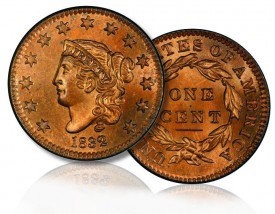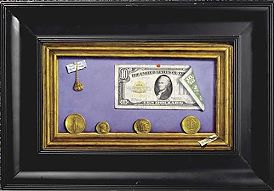By Mark Ferguson for CoinWeek – MFrarecoins.com ……
When most people think of coin collecting, they think of filling albums with coins organized by date of issue and mintmark, or organizing boxes of encapsulated coins in a similar way. But trends of collecting have changed over time. For example, collecting coins by mintmark wasn’t a recognized way of collecting until after 1893, when A. G. Heaton, the third president of the American Numismatic Association, published his Treatise on Coinage of the United States Branch Mints. That changed coin collecting at the time, as collectors began recognizing that coins minted at branch mints were often scarcer and worth more money than those minted at the Philadelphia Mint.
 Similarly, there’s been a more recent trend, taking collecting further, by collecting the die varieties of each year and mintmark combination. Die varieties are minor variations in the dies used to strike coins, such as variations in sizes of letters, positioning of stars, minor variations in details, etc., as well as imperfections of particular dies which show up on the coins, like die cracks, gouges, or rust spots. Some collectors even take collecting by die varieties further by collecting die states, which represent the condition of the dies as they were used. Dies wear, get filled in, and crack, for example.
Similarly, there’s been a more recent trend, taking collecting further, by collecting the die varieties of each year and mintmark combination. Die varieties are minor variations in the dies used to strike coins, such as variations in sizes of letters, positioning of stars, minor variations in details, etc., as well as imperfections of particular dies which show up on the coins, like die cracks, gouges, or rust spots. Some collectors even take collecting by die varieties further by collecting die states, which represent the condition of the dies as they were used. Dies wear, get filled in, and crack, for example.
The trend of collecting by die varieties has grown in popularity each time a new reference book is published on die varieties of a specific series. For example, one of the common ways to collect silver dollars today is by “VAM” variety. “VAM” stands for Leroy Van Allen and A. George Mallis who, during the early 1970s published the book, The Comprehensive Catalogue and Encyclopedia of U.S. Morgan and Peace Silver Dollars. That book was preceded by the 1963 publication of Die Varieties of Morgan Silver Dollars, by Francis X. Klaes.
Today, some of the more popular die varieties of Morgan and Peace silver dollars are known by such nicknames as “Donkey Tail,” “Scarface,” “Hot Lips,” “Shifted Eagle, “Ear Ring,” and “Broken Wing.” Such varieties are ranked by rarity, and many of them are listed in price guides. Specialized auctions are also conducted for die varieties. Researchers have identified and published information about the die varieties of most other series of U.S. coins. The coins that are most often collected by die variety are the early coins of the U.S., minted prior to 1836 when steam presses were introduced. Large cents are probably the oldest and most popular of U.S. coins to be collected this way.
Penny Whimsy, written by William H. Sheldon, M.D. in 1958, is the earliest popular reference for Large Cent varieties. This book has had a huge impact on coin collecting. It popularized “A Quantitative Scale for Condition,” which introduced a grading scale for coins that ranged from “1,” for an “identifiable and unmutilated” coin, to “70,” which represents a perfect Mint State coin. This system is the basis for the grading scale universally used today for all other series of U.S. coins. It was originally used to determine pricing for Large Cents.
Die varieties for the various series are usually referenced by a name associated with a reference book on the subject. For example, the old-time standard for varieties of early U.S. silver dollars is the “Bolender” system of classification. It was introduced in 1950, when M.H. Bolender published The United States Silver Dollars from 1794 to 1803. A typical description for a Bolender variety for a 1799 silver dollar of the “B-8” variety from the book’s “Quick Finding List” would be, “Open mouth Liberty. Die flaws inside and to right of top of final S in STATES. A line between N and I in UNITED at base.”
 In addition to classification systems and reference books for coin varieties, there are associations, societies, and clubs for specialized collectors of particular series. One of the more catchy names is the “Bust Half Nut Club,” for people who collect varieties of Draped Bust and Capped Bust design half dollars, which were minted from 1796 to 1839. The Early American Coppers club, well known as “EAC,” serves advanced collectors of Half Cents and Large Cents, minted from 1793 to 1857. Such clubs have newsletters and journals, and members usually maintain research data about varieties, die states, rarity tables, condition censuses, auction results, etc. Members also exhibit coins, and some members of these associations are often helpful in knowing who owns particular known rarities. This is highly useful information when you’re trying to acquire such pieces when they become available for sale.
In addition to classification systems and reference books for coin varieties, there are associations, societies, and clubs for specialized collectors of particular series. One of the more catchy names is the “Bust Half Nut Club,” for people who collect varieties of Draped Bust and Capped Bust design half dollars, which were minted from 1796 to 1839. The Early American Coppers club, well known as “EAC,” serves advanced collectors of Half Cents and Large Cents, minted from 1793 to 1857. Such clubs have newsletters and journals, and members usually maintain research data about varieties, die states, rarity tables, condition censuses, auction results, etc. Members also exhibit coins, and some members of these associations are often helpful in knowing who owns particular known rarities. This is highly useful information when you’re trying to acquire such pieces when they become available for sale.
This article does not include an all-encompassing list of advanced and specialized ways to collect rare coins. It is intended to give you examples of such ways to collect to help you plan out the destiny of your own collection. Another way to collect is by attractive toning, especially on silver coins. Toning is oxidation, but when it is very colorful, toning is appreciated and adds value to a rare coin. Toning comes from coins being kept in small paper envelopes, coin albums, and, especially for Morgan silver dollars, cloth mint bags. Some silver dollars develop rainbow toning, in which stripes of color, like a rainbow, appear over time on a coin’s surface. Some collectors will pay multiples of a coin’s value of an average condition coin of the same issue for one that’s beautifully toned. Coin’s can be artificially toned with chemicals, so it takes experience to distinguish “original” toning from “artificial” toning. Even the grading services have been tripped up on occasion, but if you like toned coins you might want to think about buying them in PCGS Secure Plus holders, because they’ve been laser scanned to detect surfaces of coins that have been doctored.
 Some collectors appreciate the histories of coins and collect ancillary objects related to particular coins. A good example is in the area of commemorative coins. Especially during the days prior to the popularity of encapsulating coins, the “raw” days, people collected envelopes, cardboard and wooden holders the coins were issued in, pamphlets from commemorative events associated with the coins, etc. Collecting by pedigrees from famous collectors is preferred by some advanced collectors. Similarly, some people like collecting numismatic literature, just on its own, or in association with coins, like old auction catalogs in which particular coins have appeared over time. Error coins and pattern coins are two other areas that have been growing in popularity.
Some collectors appreciate the histories of coins and collect ancillary objects related to particular coins. A good example is in the area of commemorative coins. Especially during the days prior to the popularity of encapsulating coins, the “raw” days, people collected envelopes, cardboard and wooden holders the coins were issued in, pamphlets from commemorative events associated with the coins, etc. Collecting by pedigrees from famous collectors is preferred by some advanced collectors. Similarly, some people like collecting numismatic literature, just on its own, or in association with coins, like old auction catalogs in which particular coins have appeared over time. Error coins and pattern coins are two other areas that have been growing in popularity.
Advanced collectors also use tools available in the hobby. The grading services have great online tools, like the Population and Census Reports from CAC, PCGS, and NGC. Price guides are handy, but are just that – “GUIDES.” Experienced collectors, and dealers, have been doing their own valuation research online on websites of the major auction houses. PCGS also provides auction prices realized data. Other resources to consider are online forums and specialized seminars offered at major coin shows around the country and in Colorado Springs each summer through the American Numismatic Association Summer Seminar series. These are all helpful ideas to get you thinking as you plan out how you want to build your collection.
 Mark Ferguson was a coin grader for PCGS , a market analyst for Coin Values and has been a coin dealer for more than 40 years. He has written for the ANA, Coin Dealer Newsletter, Coin World, Numismatic News, , Coin Values, The Numismatist and currently has a weekly column on CoinWeek. Mark can be reached at Mark Ferguson Rare Coins ( www.mfrarecoins.com)
Mark Ferguson was a coin grader for PCGS , a market analyst for Coin Values and has been a coin dealer for more than 40 years. He has written for the ANA, Coin Dealer Newsletter, Coin World, Numismatic News, , Coin Values, The Numismatist and currently has a weekly column on CoinWeek. Mark can be reached at Mark Ferguson Rare Coins ( www.mfrarecoins.com)




